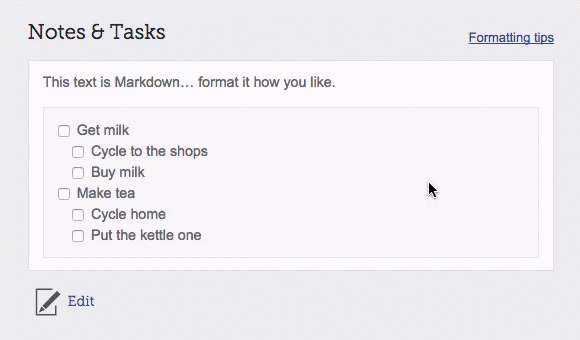Add tasks to your story cards
Planner now lets you add tasks to your story cards.
Tasks are written as bulleted lists in each card's Notes & Tasks area, by prefixing the text of the bullet with [ ] and [x] (followed by a space). The “x” indicates that the task has been completed.

Clicking a task's checkbox adds the "x" for you and saves the card (as you can see in the animation above).
Because your tasks are written in plain text, you can:
- Write them very quickly, editing and refactoring the list as your plan evolves.
- Break long lists up into multiple lists, just by inserting a paragraph or heading in the middle of the list.
I often make one list for a story's development tasks, and a separate "deployment checklist" just beneath it.
How this approach came about
When thinking about how to build a new feature, I find that breaking the problem down into tasks is a very useful exercise. Unfortunately it's not something that I usually get right first time, so I like to iterate on my task lists as I write them.
Back in 2002 (when I worked in a team that used real index cards) we'd keep notes about our stories in a Wiki (the notes wouldn't fit on the cards themselves).
We used to keep track of tasks by writing bulleted lists on the story's Wiki page, indicating which ones we'd finished by writing “[DONE]” at the beginning of each bullet. It was basic, but it worked well.
We could edit, delete and re-order tasks quickly (with the keyboard). It made writing detailed task lists a breeze.
If you estimate your stories, you've probably noticed that breaking stories down into tasks helps you make more consistent estimates. Back in 2002, our plans (with estimates based on the tasks we'd captured on our Wiki pages) became very consistent.
When designing Planner I wanted to maintain a Wiki's freeform approach to writing and editing tasks, but realised that people would appreciate being able to mark a task as complete by clicking a checkbox.
I evolved my “[DONE]” indicator into the “[ ]” and “[x]” syntax that you can see above, with the intention of converting them into clickable checkboxes.
I was excited the idea, but at the time I knew I had higher priorities to work on. By the time I came to implement it GitHub had added support for exactly the same syntax. That's always a sign that you're onto a good thing. :-)
So not only is it a great way to work with task lists, you can use the same approach in multiple apps. Better still, if you'd like to add support for this approach to another app, GitHub have released their code as open source.